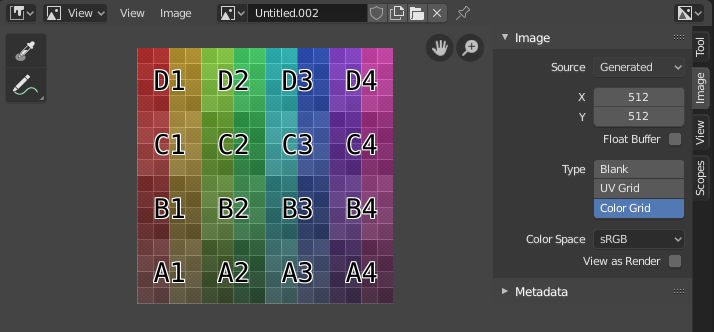简介#
The Image Editor lets you create, view, and edit images, as well as see render results and intermediate Compositor output.

具有测试网格纹理的图像编辑器。#
工具栏#
- 采样
Used to sample the color of one or more pixels in the image. As long as you hold LMB, the footer will show the following:
鼠标光标的 X 和 Y 坐标。
RGBA颜色。
Color in RGB after 色彩管理.
HSV颜色。
亮度。
- 采样尺寸
The dimensions of the square used to sample underlying pixels. If larger than 1, the resulting sample is an average of all underlying pixels.
- 标注
更多信息见 标注。
标题栏#
- 模式
- 视图
用于控制内容如何在编辑器中显示的工具。 请参阅 导航。
- 图像
用于打开和处理图像的工具。如果图像有未保存的变更,将显示一个星号。参见 编辑。
- 图像
用于选择图像的 数据块菜单。选中图像后, 图像面板 将显示在侧栏区域中。
Apart from loading existing images, you can also create new ones:

The pop-over that's displayed when clicking "New Image" in the header.#
The Tiled option creates an image with support for UDIM. For the other options, see Generated Images.
In addition to images, the data-block selector includes the following items:
Render Result: displays renders. When this item is selected, the Slot, View Layer, and Render Pass selectors become available (see below).
Viewer Node: displays the image that's fed into the 查看器节点 in the Compositor.
- 图像钉固
Prevents the Image Editor from automatically switching to the texture of the selected object. (This switching only happens if the 3D Viewport is in Texture Paint mode).
- 插槽
The render slot to view (and render to). You can create new renders without losing previous ones by selecting an empty slot before rendering. Afterwards, you compare them by pressing J and Alt-J to cycle forwards and backwards. Alternatively, you can use the number keys 1, 2, 3 etc. to select the slot with the corresponding number.
可以通过双击位于侧栏图像面板的名称来给槽位重命名。
- 视图层
要显示的 视图层。
- 渲染通道
要显示的 渲染通道。
- 视图操控器
Lets you show/hide all gizmos using the toggle button, or specific gizmos using the drop-down arrow.
- 显示通道
选择要显示的颜色通道。
- 色彩 和 Alpha:
Enables transparency and shows a checkerboard behind the image.
- 颜色:
禁用透明度。
- Alpha:
将Alpha通道显示为灰阶图像。 白色区域是不透明的,黑色区域则为透明。
- Z缓冲:
显示摄像机的景深,从裁剪起点到裁剪终点,如 摄像机设置 中所指定。
- 红,绿,蓝:
显示单个颜色通道为灰阶图像。
主视图#
Holding RMB will sample the image just like the Sample tool, except it will always sample only one pixel.